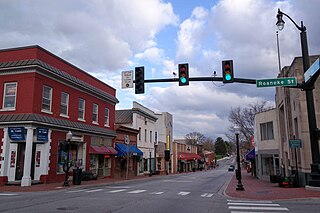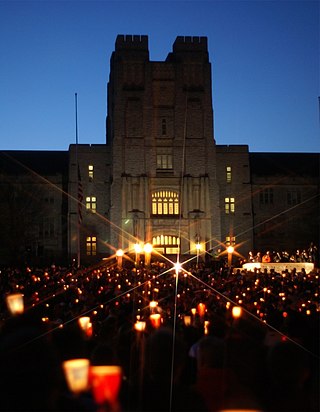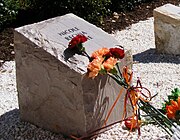
Blacksburg is an incorporated town in Montgomery County, Virginia, United States, with a population of 44,826 at the 2020 census. Blacksburg, and the surrounding county is dominated economically and demographically by the presence of Virginia Tech.

Virginia Tech (VT), formally the Virginia Polytechnic Institute and State University (VPI), is a public land-grant research university with its main campus in Blacksburg, Virginia. It also has educational facilities in six regions statewide, a research center in Punta Cana, Dominican Republic, and a study-abroad site in Riva San Vitale, Switzerland. Through its Corps of Cadets ROTC program, Virginia Tech is a senior military college.

Charles William Steger Jr. was an American architect and engineer who was the 15th president of Virginia Polytechnic Institute and State University in Blacksburg, Virginia, United States. He graduated in 1969 from Virginia Tech, where he also received his master's in architecture and Ph.D. in Environmental Science and Engineering.

Super Columbine Massacre RPG! is a role-playing video game created by Danny Ledonne and released in April 2005. The game recreates the 1999 Columbine High School shootings in Columbine, Colorado. Players assume the roles of gunmen Eric Harris and Dylan Klebold and act out the massacre, with flashbacks relating parts of Harris and Klebold's past experiences. The game begins on the day of the shootings and follows Harris and Klebold after their suicides to fictional adventures in perdition.

The Collegiate Times is an independent, student-run newspaper serving Virginia Tech since 1903. The Educational Media Company at Virginia Tech (EMCVT), a non-profit student media consortium, owns the publication. Based in Blacksburg, Virginia, the Collegiate Times publishes local news, sports, features and opinions for 5,000 print readers every Tuesday of the academic year and prints weekly summer editions. The Collegiate Times represents the only daily newspaper produced in Blacksburg and also provides its content online via its website, mobile app, and various social media outlets.

The Virginia Tech shooting was a spree shooting that occurred on April 16, 2007, comprising two attacks on the campus of the Virginia Polytechnic Institute and State University in Blacksburg, Virginia, United States. Seung-Hui Cho, an undergraduate student at the university and a U.S. resident originally from South Korea, killed 32 people and wounded 17 others with two semi-automatic pistols. Six others were injured jumping out of windows to escape Cho.

Kevin P. Granata was an American professor in multiple departments including the Departments of Engineering, Science and Mechanics and Mechanical Engineering at Virginia Polytechnic Institute and State University, in Blacksburg, Virginia. Granata held an additional academic appointment as a professor in the Virginia Tech-Wake Forest School of Biomedical Engineering and was an adjunct professor at the University of Virginia in the Department of Orthopedic Surgery. During the Virginia Tech shooting, he shepherded students into his office in order to safeguard them. He was then killed by Seung-Hui Cho after he went to investigate and intervene.

Seung-Hui Cho was a South Korean mass murderer responsible for the Virginia Tech shooting in 2007. Cho killed 32 people and wounded 17 others with two semi-automatic pistols on April 16, 2007, at Virginia Tech in Blacksburg, Virginia. This killing is the deadliest school shooting in US history, and was at the time the deadliest one-man shooting rampage in modern US history and deadliest mass shooting in US history. A senior-level undergraduate student at the university, Cho died by suicide after police breached the doors of Virginia Tech's Norris Hall which Cho had locked with heavy chains, where most of the shooting had taken place.
Lucinda Roy is an American-based British novelist, educator and poet.

This timeline of events from the Virginia Tech shooting lists times in Eastern Daylight Time (UTC-4).
Jocelyne M. Couture-Nowak was an instructor of French in the Department of Foreign Languages and Literature at Virginia Tech in Blacksburg, Virginia and was the only Canadian victim of the Virginia Tech shooting. She was a native of Canada, and while residing in Truro, Nova Scotia, she co-founded the first Francophone school in the region.

New Life Christian Fellowship (NLCF) is an evangelical Christian church in Blacksburg, Virginia that ministers to the Virginia Tech and New River Valley communities. An estimated 200 worshipers attend one of the church's three weekly gatherings, most of whom are college students attending services on the Virginia Tech campus.

V-Tech Rampage is a controversial amateur action video game that recreates the 2007 Virginia Tech shooting on the campus of Virginia Tech in Blacksburg, Virginia, United States. The game was created by 21-year-old Ryan Lambourn from Australia. The Flash-based game came to light when it was uploaded to Newgrounds using Lambourn's screen name Master PiGPEN.
The Educational Media Company at Virginia Tech (EMCVT) is an independent governing body over student mass media organizations of the Virginia Tech campus. The EMCVT board of directors is made up of Virginia Tech faculty and staff, students, and members of the Blacksburg, Virginia community. As the parent company, EMCVT owns the copyrights on all media produced by its divisions.

The Northern Illinois University shooting was a school shooting that took place on Thursday, February 14, 2008, at Northern Illinois University in DeKalb, Illinois. Steven Kazmierczak opened fire with a shotgun and three pistols in a crowd of students on campus, killing five students and injuring 17 more people, before fatally shooting himself.
TGSCOM, Inc. was an American online gun dealer based in Green Bay, Wisconsin which sold guns and sporting goods through more than 150 websites, including thegunsource.com and topglock.com. TGSCOM was founded in Arizona in 1999 by Eric Thompson, and was based in Tempe, Arizona until October 2006 when the operation was moved to Green Bay. TGSCOM is no longer in business as of May 20, 2012.
On the morning of August 26, 2015, news reporter Alison Parker and photojournalist Adam Ward, both employees of CBS affiliate WDBJ in Roanoke, Virginia, United States, were fatally shot while conducting a live television interview near Smith Mountain Lake in Moneta. They were interviewing Vicki Gardner, executive director of the local chamber of commerce, when all three were attacked by a gunman. Parker, age 24, and Ward, age 27, died at the scene, while Gardner survived.
Mass shooting contagion theory is the studied nature and effect of media coverage of mass shootings and the potential increase of mimicked events. Academic study of this theory has grown in recent years due to the nature of mass shooting events, frequency of references to previous rampage shooters as inspiration and the acquisition of fame using violence, particularly in the United States. The Columbine High School massacre is cited as being the first shooting to receive nationwide 24/7 publicity, giving both shooters near instant widespread infamy, and thus often is claimed by researchers as being a source of inspiration for would be copycat mass shooters.

The Columbine effect is the legacy and impact of the 1999 Columbine High School massacre. The shooting has had an effect on school safety, policing tactics, prevention methods, and inspired numerous copycat crimes, with many killers taking their inspiration from Eric Harris and Dylan Klebold by describing the two perpetrators as being martyrs or heroes.

On January 21, 2009, Zhu Haiyang (朱海洋), a graduate student from Ningbo, China, decapitated another graduate student, Yang Xin (杨欣), at Virginia Tech.














